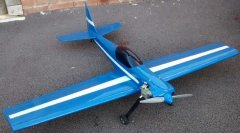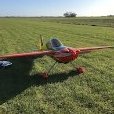All Activity
- Past hour
-
Personally I would stick a shim under trailing edge of top wing. Most bipes I have had have less incidence on the top wing.. few ultimates were neutral, a couple, 1 degree negative on top wing. All flew well.. and take out some of your added down thrust. Or else that will mask the effect of the wing incidence adjustment
-
Didnt realise the motor shaft was quite that long ,20mm leaves plenty stuck out of the prop adaptor Found a 6inch folding prop in my bits box that someone donated a while back , no idea on the pitch (no clues on the prop blades ) Dont know if I will need to cut the motor shaft down as I dont have the motor mounting or cowl yet. Unfortunately the mate I usually get 3d prints from has moved to Germany so I will need to find another source.
-
I've gone ahead and added a 6mm shim made of silicone sheet to the rear mounting plate on the undercarriage. It certainly seems to have raked things forward. Last time I tried to take off at my field it kept on nosing over, and I don't think we've ever managed to land without nosing over as it comes to a stop. Let's see how this works out...
-
Thanks for all the replies. Being an artf I've presumed the incidences are correct and as all mounting are predrilled there is no wiggle room. I'll try a bit more down thrust and move the c of g. John in answer to your question if I slow it down it starts to drop a wing very rapidly makes landing interesting !
-

Laser Cutters, any thoughts?
Ron Gray replied to Richard Thornton 2's topic in Modelling Money Savers...
I've never had a cut piece twist neither have the pieces I'm cutting from although I do cut from slightly twisted stock! What quality of plywood are you cutting? - Today
-
You know my feelings Richard having flown it. I'd bite your hand off for one.
-

Unstable model
john stones 1 - Moderator replied to Glenn Philbrick's topic in All Things Model Flying
Applying side and downthrust is a no brainer for me, you've applied some but was that enough ? Flicky can cover a few things, c.g, amount of movement for example, how's it behave throttled back ? -
I've got a Robart Incidence meter but I find using a cross line laser easier nowadays. Otherwise any modern Smart phone can be used as an incidence meter. You just use an appropriate app and a simple jig or double sided tape to hold the phone in place.
-
The Yak was one of those designs that just flew great straight form the first flight . The La7 is also good in all sizes , but the Yak is a little more frisky , but at the same time easy to land with a slow stall . Its light and simple so very quick to make . Crafty wing section and light loading is the trick . Personally , I don't even think of it in the context of todays disputes . If we do that , we better stop flying Mustangs and Thunderbolts . Anyone who has seen the real Yaks fly at an air show would recognise the same traits in the model . I might ask people their views at the Best Of British regarding the Yak kit . Seems that there might be a dozen people out there for it . sounds nice too ... https://www.youtube.com/watch?v=zI_1jBb_0v0&t=3s
-
Frankly, I reckon if your Yak flys well and price is good It'll sell, It's a toy aeroplane and for me some folk take themselves too seriously, not buying a Yak will change nowt, other than you won't have a Yak.
-
Agree with all above comments as I said before would love one
-
For me its about the model, how well it flies + ease of build etc I am sure there will be a captured/post war scheme if someone really does not want red stars on theirs. How does the Yak fly compared with the WR LA7?
-
I do know of folks who have reschemed their previously Russian models as Ukrainian . Not something that I'd do, but also worth bearing in mind that Yak is a Soviet aeroplane, rather than anything to do with the current regime, so it's a tenuous link for folks to make such changes. I only have a couple of Russian aeroplanes, both Sukhoi pusher "jets" and they still retain their red stars. For WWII USSR aeroplanes it's a no brainer, they were our staunch allies at the time, plus you've got her posed next to an FW190 with a naughty cross on the fin 😉 They both look very nice and should stay as they are.
-
The issue I find with the commercially available incidence meters is that there is always some angular play in the sliders which can upset the readings. My solution to this is to stretch a lightweight rubber band between the clamp screws which always holds the clamps at a consistent angle.
-
It's all about the machine, not the regime. And this model, well my one, is like a rat up a drain pipe!
-
I have been flying the Yak today after its been off duty for a few months . It has a sound system and air whistle and despite blustery conditions it still flies great . What is the general opinion regarding the Yak given the current Russian situation ? Ive never made the kit available to the public .
-
Aaaand done! Paint scheme is based on that of Spitfire Pr.XI PL983, currently based at Duxford.
-
Well renewing the RX packs certainly put my mind at rest because I compared the Telemetry chart using old and new packs with flying the same aircraft and a similar freestyle aerobatic pattern. The old RX pack showed noticeable dips at times of high servo deflection. The new pack showed a clear improvement with very little voltage deviation during high servo defection. One thing which may have made a difference is the higher discharge rate of the Optifuel lipos compared to the Turnigy packs. Don't know for sure. I might have dodged a bullet there, but I can't take too many risks with these large scale models.
-
I'm not at all surprised that the vast majority of modellers don't check their creations or purchases with an incidence gauge. If they are following any decent set of instructions then they would have checked the alignment of the tailplane laterally, checked that the tailplane and fin are square and proceeded on that basis. The vast majority of modellers almost certainly do not own, or have never used an incidence mater. FWIW I've got a Robart Incidence meter, as I thought it was a good idea. It's in a draw and it hasn't been used in donkey's years. If one is purchasing an ARTF or building from a kit then it's a pretty fair assumption to make that the incidences ought to have been sorted out by the manufacturer. If one is building from a plan or from scratch, and especially with a complex model, then the case for using the meter is stronger, but I expect that would represent a small minority of modellers - for most of us TLAR is good enough.
-
Like many here, I've built from both kits and plans as well as a try at a couple of own designs, yet I also assemble ARTFs and so have a reasonable idea of what's right as regards incidence. I have a Robart incidence meter that gets used a lot and I've also used my phone - I prefer the Robart mechanical meter.
-
Don't disagree, but just pointing out there will probably be no data to confirm right or wrong, on an ARTF. Just experience....
-
Given that the skills and knowledge to actually build a model are not needed with an ARTF, then a little research into trim and rigging angles is hardly a big ask. Not absolutely needed as one would expect an ARTF to be pretty much correct, but it's just nice to confirm that no glaring errors have been built in and the chances of a smooth first flight will be assured as much as they can be.
-
Laser Cutters, any thoughts?
Richard Thornton 2 replied to Richard Thornton 2's topic in Modelling Money Savers...
This what I mean Ron. The piece has now taken a lovely bow to it. Do you need to ‘press’ the cutouts between something straight until they are ready to be used? -
I'd be surprised if anyone assembling an ARTF would know what was right, and what was wrong..... Certainly makes sense for a plan build (and possibly a 'real' kit)
-
https://www.4-max.co.uk/robart-incidence-meter.htm Similar idea to a heli pitch gauge but larger to accomodate aircraft wings. Not sure if commercial ones are still available - certainly not the Robart.









.thumb.jpg.77e29add7c1431e70c716c79b427fca9.jpg)


